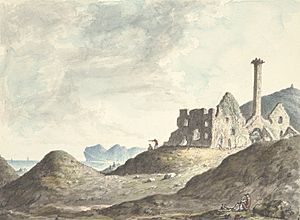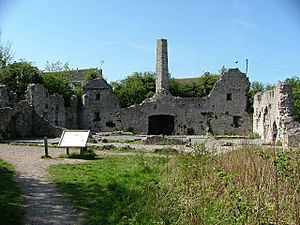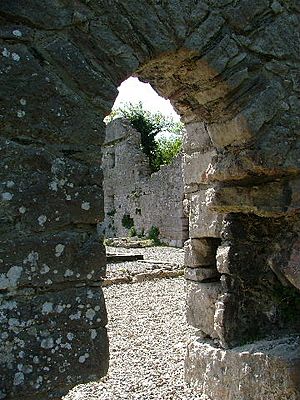Llys Euryn facts for kids
The old ruins of Llys Euryn are found on a wooded part of Bryn Euryn. This is a limestone hill near Rhos-on-Sea (Welsh: Llandrillo-yn-Rhos) in Conwy, north Wales.
You can still see three sides of the building. There are also parts of inner walls, a full fireplace, and a chimney that stands about 50 feet tall. Two other fireplaces and some windows are also visible. The amazing history of Llys Euryn makes it a very interesting and important old building in north Wales.
Contents
The History of Llys Euryn
Llys Euryn was once an important estate in the area. It was owned by a powerful person named Ednyfed Fychan. He lived there until 1246.
Who was Ednyfed Fychan?
Ednyfed Fychan was a very important official. He was like a chief manager or advisor. He worked for the Kingdom of Gwynedd in northern Wales. He served two famous Welsh leaders: Llywelyn the Great and his son Dafydd ap Llywelyn. Ednyfed Fychan was also an ancestor of Owen Tudor. This means he was related to the famous Tudor dynasty of English monarchs.
Fires and New Buildings
People believe that Llys Euryn was burned down in 1409. This happened during a big revolt led by Owain Glyndŵr. But the house was either fixed or rebuilt soon after. The building you see today is from the late medieval period. The Conwy Family likely lived here until 1629. Then, they sold it to Sir Peter Mutton.
Later Uses of the Site
Much later, in the late 1800s, there was a limestone quarry nearby. Workers built a small hut against one of the walls at Llys Euryn. This hut was thought to store materials used for blasting rocks.
Someone once tried to blow up the tall chimney stack. They made a hole in the side of the fireplace. But luckily, the chimney stayed standing! For a long time, the site was left overgrown and forgotten.
Saving Llys Euryn
In 1998 and 1999, a big project began to save Llys Euryn. Workers cleared away a lot of plants and trees. They uncovered the inner walls and a large fireplace. The old blasting hut was removed. The hole in the chimney was fixed. Finally, stone chippings were added to stop plants from growing back. An information sign was also put up to tell visitors about the site's history.




